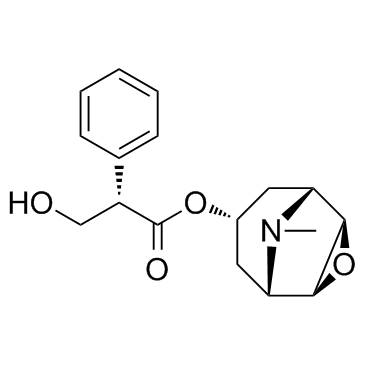氧托溴铵

氧托溴铵结构式

|
常用名 | 氧托溴铵 | 英文名 | Oxitropium Bromide |
|---|---|---|---|---|
| CAS号 | 30286-75-0 | 分子量 | 412.31800 | |
| 密度 | N/A | 沸点 | N/A | |
| 分子式 | C19H26BrNO4 | 熔点 | 203-204° (dec) | |
| MSDS | N/A | 闪点 | N/A |
氧托溴铵用途Oxitropium bromide是毒蕈碱受体拮抗剂。它是一种用于治疗哮喘和慢性阻塞性肺疾病的抗胆碱能支气管扩张剂药物。 |
| 中文名 | 氧托溴铵 |
|---|---|
| 英文名 | Tersigat |
| 英文别名 | 更多 |
| 描述 | Oxitropium bromide是毒蕈碱受体拮抗剂。它是一种用于治疗哮喘和慢性阻塞性肺疾病的抗胆碱能支气管扩张剂药物。 |
|---|---|
| 相关类别 | |
| 靶点 |
mAChR[1] |
| 体外研究 | Oxitropium bromide是一种毒蕈碱拮抗剂,可阻断musucarinic乙酰胆碱受体(mAChR)。未经处理的膈肌的氧托溴铵和注射内毒素的膈肌孵育不会增加体外剂量依赖性的力-频率曲线;然而,它会导致两种类型的肌肉都抗疲劳[1]。 |
| 体内研究 | 吸入氧化溴化物在吸入后2小时将力-频率曲线向上移动,并抑制体内注射内毒素引起的力-频率曲线的减少[1]。 Oxitropium bromide强烈且持续地抑制乙酰胆碱(ACh)诱导的抗性。溴化氧噻嗪溴化物可以防止组胺,5-羟色胺,白三烯D4或抗原诱导的耐药性增加[2]。以1.5μg或更高的剂量吸入抗胆碱能药物氧托溴铵可大大减少静脉注射组胺产生的粘液评分的降低,但吸入的组胺不会减少[3]。 |
| 动物实验 | 小鼠:在氧托溴铵吸入组中,动物通过75-mL间隔物从氧托溴铵MDI(计量吸入器)吸入2次,然后解剖膈肌并立即测量收缩性,1小时,2小时和4小时后(每组n = 5只动物)。将动物置于离心管(内径= 30mm)中,在底部具有圆孔(直径= 10mm),其鼻和嘴通过孔暴露以进行呼吸。氧托溴铵MDI(定量吸入器)将2次喷射释放到与管连接的间隔物中。吸入氧托溴铵气雾约10秒钟,而动物则通过管孔自发呼吸[1]。 |
| 参考文献 |
| 熔点 | 203-204° (dec) |
|---|---|
| 分子式 | C19H26BrNO4 |
| 分子量 | 412.31800 |
| 精确质量 | 411.10500 |
| PSA | 59.06000 |
| 储存条件 | -20°C,密闭,干燥 |
|
~% 
氧托溴铵 30286-75-0 |
| 文献:Journal of the American Chemical Society, , vol. 78, p. 3448,3452 |
|
~84% 
氧托溴铵 30286-75-0 |
| 文献:Banholzer; Pook Arzneimittel-Forschung/Drug Research, 1985 , vol. 35, # 1 A p. 217 - 228 |
|
~% 
氧托溴铵 30286-75-0 |
| 文献:Arzneimittel-Forschung/Drug Research, , vol. 35, # 1 A p. 217 - 228 |
|
~% 
氧托溴铵 30286-75-0 |
| 文献:Arzneimittel-Forschung/Drug Research, , vol. 35, # 1 A p. 217 - 228 |
|
The development of anticholinergics in the management of COPD.
Int. J. Chron. Obstruct. Pulmon. Dis. 2(1) , 33-40, (2007) Anticholinergics have been used to treat obstructive respiratory disease for many years from historical preparations of the deadly nightshade genus, to the more recent developments ofipratropium, oxit... |
|
|
Anticholinergic therapy for acute asthma in children.
Cochrane Database Syst. Rev. 4 , CD003797, (2012) Inhaled anticholinergics as single agent bronchodilators (or in combination with beta(2)-agonists) are one of the several medications available for the treatment of acute asthma in children.To determi... |
|
|
Effect of resection of the posterior nasal nerve on functional and morphological changes in the inferior turbinate mucosa.
Acta Otolaryngol. 128(12) , 1337-41, (2008) The underlying pathophysiological mechanisms of the posterior nasal nerve (PNN) resection involved the suppression of the secretogogue motor and the inhibition of neurogenic inflammation induced by pa... |
| Oxivent |
| Oxitropium |
| Oxitropium bromide |
| Ba-253-BR-L |
| Ventilat |
| oxytropium bromide |
| Bromure d'oxitropium |






 CAS号51-34-3
CAS号51-34-3
